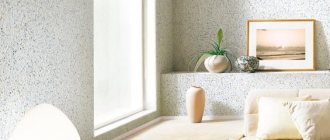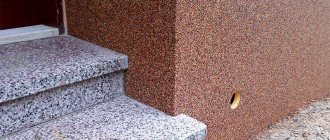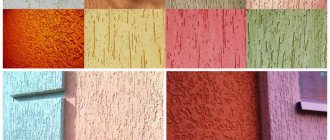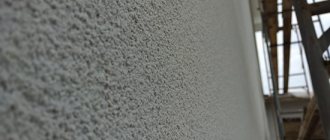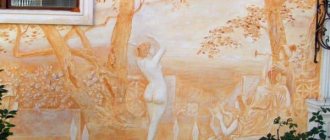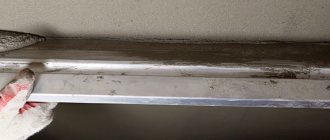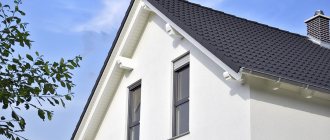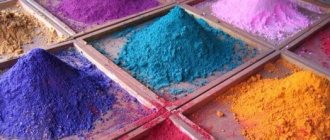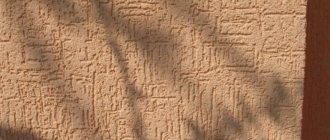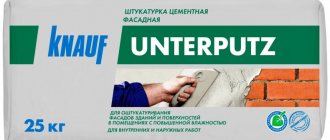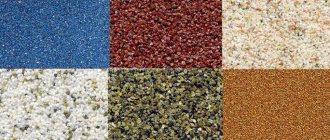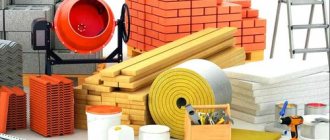At the final stage of repair and finishing work, the finishing coating of walls, facades and various surfaces is carried out. In most cases, various types of decorative plaster are used for the finishing coating. Some mixture options are difficult to apply, form uneven surfaces and form a complex texture.
However, there are special coatings that do not require much effort when applied; one of these coatings is marble plaster for facades. Today we will look at the features of its application, and also share useful tips for comfortable finishing.
Composition and characteristics
Facade plaster with marble chips may contain the following elements:
- Marble or granite chips are used as a base, which gives the characteristic appearance and properties of the treated surface. The crumbs differ in size, color and basic technical characteristics.
- To keep the crumbs on the wall, a binding component is used. For this purpose, acrylic resins are added to the composition to increase adhesion to the surface.
- In addition to the main components, the plaster may contain additional components. Among them are bactericidal compounds, water-repellent impregnations, dyes and decorative glitter.
The base composition will affect the characteristics of the coating. Among the key features of this plaster it is worth noting the following:
- High wear resistance and excellent quality of the material, the crumbs are not subject to mechanical stress.
- Hardness and strength of the coating.
- Thanks to water-repellent components, the coating is not exposed to moisture.
- Plaster allows steam to penetrate through porous structures.
- Environmentally friendly components.
- Good connection to any type of surface.
- For exterior work, marble plaster is used for finishing purposes.
- Marble plaster can also be used for interior decoration.
Where is it used?
Since marble plaster is an environmentally friendly material, it can be used on any surface - at the final stage of finishing, both to cover the walls of the interior of the house and to decorate the facade. At the same time, it looks discreet, but impressive, stylish, and presentable. It is used to finish concrete and brick, stone and wood, plasterboard and chipboard. It even sticks to water-based paint!
On a note! Using marble plaster, you can decorate columns, balconies, and all kinds of arches very beautifully.
Steps finished with marble plaster
However, such plaster is rarely used in the interior of a living space - the material is too “cold”. But flights of stairs, halls, and corridors decorated with its help will look harmonious. And on the facade, such plaster always looks advantageous.
Decorative plaster TERRACO (mosaic, marble chips)
Stone chips in the exterior
Types of marble plaster for exterior use
The presented coating option is available in several versions, among which it is worth noting:
- Venetian or Venetian is a material made from marble flour.
- Standard marble plaster, which is divided according to the size of the granules included in the composition. There are small, medium and large fractions of particles.
- There is also a mosaic version of the coating, which contains additional inclusions of mineral elements (granite, quartz, malachite, lapis lazuli...).
What is this
Marbled plaster is a special type of decorative coating that is often used to decorate houses and apartments in a classic style. When purchasing a mixture, you should keep in mind that sellers may call it Venetian. This decorative coating, despite its popular name, was invented not in Venice, but in Ancient Rome.
In those days, the exquisite design of a home became a sign of the owner’s good taste and wealth. However, processing natural stone was too expensive and required a lot of effort, so clay was the main finishing material. They began to add marble dust and slaked lime to it. The result was an elastic material that could be used to decorate both vertical and horizontal surfaces.
After the fall of Ancient Rome, this finishing method briefly lost its popularity. They remembered him in Venice during the Renaissance. The material began to be used to imitate marble slabs, because... it was almost unaffected by changes in humidity. Its spread was facilitated by ease of application, relatively low price and availability.
If the application technology was followed, the coating resembled natural marble. To enhance the decorative effect and protect against environmental factors, the surface was covered with wax and thoroughly polished. Later, various natural dyes began to be introduced into the mixture. This expanded the scope of application of the material.
Correctly applied classic marbled plaster has a unique pattern. In addition, thanks to modern dyes, this material is actively used to imitate jasper, jade and many other natural minerals. There are several finishing options. If necessary, a rough surface can be obtained.
When using Venetian to create an imitation of polished natural stone, the coating results in a glossy finish. It reflects light and visually expands the room. Some craftsmen use this type of plaster to create complex images.
Calculation of material quantity
In order to correctly calculate the amount of material that will be required for finishing work, you should find out the material consumption.
The consumption of the mixture during finishing work differs depending on the fractions of the crumbs included in the composition.
Fine-grained marble plaster for facade finishing has a consumption of 1-2.5 kg per square meter, when using the middle fraction you will need 2-3 kg per 1 m^2, coarse-grained chips have a consumption of up to 5 kg for the same area.
The amount of mixture can be calculated by multiplying the consumption of materials by the total surface area that needs to be covered with the solution.
Ready mixes
To save money, many builders and building owners prefer to make marble plaster themselves. For this, a binder, a filler represented by marble chips, and pigments are used. Typically, acrylic putty is used for the bond, which is easily replaced with white cement M500.
Pre-mixed formulas, which are mixed with water before use or sold in liquid form, have many benefits. These include:
- optimal composition in which all elements are combined in suitable proportions;
- ease of use;
- there are no toxins or harmful components in the composition;
- the manufacturer offers a guarantee;
- availability of recommendations from the manufacturer, following which you get excellent results;
- sometimes mixtures are sold complete with tools that can be used to create a beautiful texture on the facade of a building.
The disadvantages of the finished material include high price and significant consumption. The cost of 15 kg of the finished mixture is approximately 1.5 thousand rubles.
How to prepare a mortar for plaster with crumbs
In most cases, manufacturers produce prepared mixtures for application to walls, but in some cases it will need to be further diluted with water. The label of the container with the material will indicate the recommended amount of water to create a suitable consistency.
Before use, you must carefully read the instructions and recommendations of the manufacturers.
Before use, open the container, add the specified amount of liquid, and then thoroughly mix the material with a construction mixer at medium or low speed. After this, the material will be ready for use.
Varieties
When choosing the right Bayramix plaster, you need to take into account the features of the various types of brand products and their properties.
Is it possible to keep wormwood in an apartment?
Let's look at popular types of coatings.
Marble
The binder in Bayramix marble plaster compositions is a polymer binder, and not cement, gypsum or lime. This binder is acrylic.
Coatings based on this polymer are suitable for both interior and exterior decoration.
Acrylic is environmentally friendly and safe. Such plastering materials are filled with marble chips of various colors, shapes and sizes.
There are several popular marble plasters from Bayramix:
Bayramix marble plaster coatings are suitable for use in a wide range of conditions. To care for them, you can use a bleach solution.
Such plasters are sold in plastic buckets. The material is ready for use.
Venetian
Such plasters imitate natural untreated blocks of stone. They are able to reproduce a variety of textures: limestone, jasper, malachite, marble, sandstone, lapis lazuli, granite.
To make the imitation of natural material as accurate as possible, you can apply the plaster composition in two layers.
Such coatings can be painted with special glaze materials.
Textured
The company presents several types of textured plaster coatings:
Composition of marble plaster
In order to create the appearance of a natural material, marble plaster contains marble chips and stone dust. To ensure that they are firmly bonded to each other, manufacturers use special preservatives that will dissolve the agents and repel additives. Marble chips allow you to make walls not only beautiful, but also a little rough to the touch. In some cases, granite chips are used instead of marble. Pebble modern decorative plaster involves the simultaneous use of granite and marble chips.
This does not negatively affect the quality of the material, but the finishing will have completely different characteristics. For example, marble has a good adhesion rate, but it is not strong enough. Granite is characterized by high mechanical resistance.
The resulting material will have both characteristics. Some other components can also be used to enhance properties and improve performance.
Required Tools
Wall finishing work is performed using the following tools:
- Construction mixer with attachment.
- Masking tape to define the boundaries of application.
- A container in which you can stir the solution.
- Spatulas and graters for applying and distributing the mixture.
- Roller for applying material.
- Stepladder when working at height.
- Rags.
- Respirator, gloves and protective gown.
- Trowel, level, pencil, tape measure for easy marking.
Application technology
To apply the solution yourself you will need:
If you use a dry composition, then you will also need a drill with a mixer attachment for mixing.
Important! The surface on which the solution is applied should have a humidity of no more than 5-10%. It is advisable to start exterior finishing work in the warm season, in dry weather.
Procedure:
The plastering procedure is shown in the video tutorial below:
The solution dries over the next 24 hours, after which the finished coating can be treated with a protective varnish.
The consumption of marble plaster depends on the size of the chips, the thickness of the layer and some other parameters. On average, it takes up to 1-2 kg of fine-grained, 4-5 kg of medium-grained and up to 8 kg of coarse-grained mortar to process 1 m².
Façade finishing with marble plaster
After preparing the tools and materials, you can begin the main stage of the work. The finishing of the façade with marble plaster is carried out in several stages. We will talk about each of them in detail below.
Surface preparation
In order for marble plaster used for exterior work to decorate the appearance of the building, the walls should be carefully prepared. To do this you need to do the following:
- Removing the old coating, layer-by-layer removal of the previous plaster or other materials that were applied to the surface.
- To create a smooth surface, you need to clean the walls with a brush and go over them with a sanding disc.
- If there is mold and fungal colonies, the wall should be thoroughly cleaned and treated with chlorine-containing substances.
- All chips, cracks and recesses in the walls should be repaired with cement mortar. It is necessary to create an even coating so that the decorative plaster is firmly attached to the surface.
- After the cement mortar has dried, it is necessary to apply a layer of primer for better adhesion of the material.
- In the final stage, you should wait until the walls are completely dry. Before starting work, humidity should not exceed 5%.
Manual coating
The process of applying the material manually is carried out in accordance with the algorithm presented below:
- Apply a little material to the trowel. It is necessary to apply the material to the surface at an angle of 60 degrees to the wall. It is important to maintain the angle of inclination and uniform distribution of the mixture.
- It is necessary to repeat the procedure until the solution completely covers the wall with an even layer. If necessary, you can interrupt the work using masking tape. To do this, glue a strip of tape, apply the material to the indicated level, and then peel off the tape with the remnants of the still raw material.
- As soon as all the material has been applied to the wall, you should start grouting it. 20-30 minutes after application (the material must be damp), use a stainless steel trowel to level the surface in a circular motion. The trowel should be clean and slightly damp so that the material does not stick to the tool.
- After the material has completely dried (about 24 hours), a varnish coating is applied, and then wait another 12 hours for it to dry.
Mechanical method of finishing the surface with marble chips
If desired, you can use special mechanical devices; they are used to spray the finished composition.
The most popular option is a crumb thrower, which allows you to quickly cover the surface with an even layer.
Shredder
The mechanism consists of a bucket, a nozzle and a compressor that pumps air. The diameter of the nozzle during operation should not exceed 6 mm, the working pressure is 6-7 atmospheres, the material must be applied at a distance of 25-50 centimeters from the wall.
When using a crumb blower, you need to fill the container with material, bring the mechanism to the wall, and then spray the composition from top to bottom. During spraying, you need to ensure that the crumbs are evenly distributed. After applying the material, final processing is performed and a protective layer of varnish or other hydrophobic coating is applied.
Interior use
There is a difference between marble plaster for interior and exterior. It lies in the size of the marble grains. Fine-grained chips ranging in size from 0.2 to 1 mm are used for decorative finishing inside, and medium-grained (1-3 mm) and coarse-grained (3-5 mm) are used for the exterior. Such information will play a role if you are planning to independently purchase material in a store on a nearby street or on the Internet.
A variety of color solutions allows you to realize any designer’s idea. The material can be used to decorate walls in any room: bedroom, hallway and even bathroom, since marble plaster is moisture resistant. It fits easily on surfaces made of different materials. Wood, brick or concrete, with proper preparation, will become an equally reliable base.
If you have decided that you will have marble plaster, what material consumption should be included in the repair estimate? The calculation is very simple. For absolutely smooth walls with an average layer thickness, you will need 100-200 g per square meter. It is also interesting that a layer of marble plaster will not only serve as a beautiful decoration, but will also solve the issue of sound insulation.
When working with marble plaster, the designer’s imagination is unlimited. In the interior, it can be used both for complete wall decoration and for creating accents on individual elements. The finishing of cornices and columns is popular. You can further emphasize the beauty of this material using directional light.
Original facade decoration
Due to its high mechanical resistance, marble facade plaster is used for finishing walls, arched structures and plinths. In addition to the decorative effect, the material will add strength to surfaces. It is resistant to mechanical stress and environmental influences, which is why it is so often used for finishing elements in public places: parks, terraces.
The relatively low cost and durability of marble plaster are undeniable advantages. “Wearing it out” is very difficult, but applying it is simple. Anyone can handle the finishing process. It is enough to carefully study the sequence of actions and strictly follow the instructions.
Application stages and features
The list of the most unpretentious finishing materials includes marble plaster; you can easily learn how to apply it in a few hours. The main thing to remember is that the surface is properly prepared. The effect of marble coating depends on how smooth and clean the wall is. Also, to achieve maximum smoothness, you should choose a high-density product and apply it in a thin layer.
Before you start work, prepare the necessary tools. You will need: a mixing drill, a spatula, a flat brush and a steel float.
- Before application, the surface should be cleaned of dirt. All uneven surfaces should be filled and sanded. Minor cracks can only remain if you use coarse plaster.
- To ensure reliable adhesion of marble plaster to the wall, apply a primer and wait several hours until it dries completely. Go over it again with a primer in the color of the plaster.
- Apply marble plaster to the surface using a spatula. For the interior, a tool measuring 30 cm is sufficient. For facades, a larger spatula is used.
- Gradually take the mixture and carefully stretch it along the wall. To do this, you need to make an effort and press the spatula well, ensuring reliable adhesion of the plaster to the surface. Try to distribute the plaster evenly and finish working the entire wall before it dries so that the joints are not visible.
- Wait half an hour and apply the next layer. The thickness of one layer can be from 2 to 4 mm.
- There can be up to 10 layers of marble plaster, depending on the effect you plan to achieve.
- Sand the last layer with fine-grained sandpaper.
- Marble plaster should dry for two days at a temperature not lower than +5⁰C.
There should be no difficulties with applying marble plaster. It fits easily on any surface, including unprepared ones. Largely due to this, marble plaster receives the best reviews, both from construction professionals and from those who like to do their own repairs. It combines the best qualities of modern finishing materials: aesthetics, wear resistance and accessibility
To avoid mistakes, pay attention to the manufacturer, trusted companies, and take into account customer reviews. Your experience of using this material will be successful and will bring pleasure in the process of further use.
Additional façade painting using marble chips
Decorative plaster of the facade with marble chips allows you to apply paint on top of it. If desired, you can give the coating a bright appearance and create a unique design.
It is recommended to apply paint 2-3 days after finishing work. Complete drying will give the coating strength, after which it can be painted.
It is also possible to paint the facade to update the color scheme if the coating has not been changed for a long time. For convenience, you can paint the surface using a roller.
Advantages and disadvantages
- wear resistance and strength;
- does not fade in the sun;
- resistance to any weather (not afraid of heat, cold and water);
- applied to any surface: drywall, concrete, plaster, cement, etc.;
- attractive appearance;
- vapor permeability;
- longevity;
- allows the wall to “breathe”;
- easy to clean;
- masks surface irregularities and defects.
- heavy covering;
- high consumption (from 2.5 to 4.5 kg is consumed per 1m2);
- if the crumb is applied to ferrous metal without a special primer, then, like any water-based coating, it stimulates corrosion;
- acrylic in a thick layer (for large-textured granules) reduces vapor permeability, so some manufacturers do not recommend using the material for finishing insulated “breathable” structures, where mineral wool slabs are used as insulation. It is also not recommended to use it in the basement parts of buildings, because groundwater leakage is possible in the case of weak waterproofing.
- on an external wall (in very hot weather), the temperature of the material can reach 80-90 0 C and the dirt that was on the surface is firmly eaten away. Although rare, this also happens.
- it is impossible to repair a specific “piece” of the wall;
The strength of the material is both a plus and a minus. After all, over time, you can replace the old chips only by tearing it off along with the wall. It adheres so tightly that it becomes “monolithic”. Therefore, a new finishing material, be it paint or wallpaper, will have to be applied over the old one, having previously been puttied.
The color shade of the product and its size may differ from those shown in the photograph.
- Prices
- Description
- Characteristics
- Reviews
- Ask a Question
Volume Color Price 15 kg EVER GREEN K Buy in 1 click 15 kg MAGNOLIA WHITE K Buy in 1 click 15 kg PEACH ROSE K Buy in 1 click 15 kg KASHMIR GOLD K Buy in 1 click 15 kg RED STONE K Buy in 1 click 15 kg ROYAL WHITE N Buy in 1 click 15 kg MAGNOLIA WHITE N Buy in 1 click 15 kg KASHMIR WHITE N Buy in 1 click 15 kg PEACH ROSE N Buy in 1 click 15 kg KASHMIR GOLD N Buy in 1 click Do you want to create a marble effect on the surface? To do this, it is not necessary to spend money on expensive materials. Marble plaster "Kroshka Economy" allows you to obtain a coating reminiscent of natural marble.
Base finishing
Marble plaster for the plinth can be used for finishing purposes. The application process does not differ from the standard finishing work. You should first prepare the base, repair all the unevenness, cover it with a layer of primer, and wait until the walls are completely dry. After this, manual or mechanical distribution of the mixture is performed using special equipment.
Why do you need to finish the base?
Base marble plaster is necessary primarily to protect the base from excessive exposure to moisture. Since the basement floor is located below the planning level of the building, it is susceptible to moisture.
A durable coating will protect the walls from condensation, mold and various fungal colonies.
Scope of application
Marble plasters are excellent for finishing surfaces that require enhanced protection from moisture - foundations, plinths, external walls of houses, as well as saunas, swimming pools and bathrooms.
Marble plaster applied to the wall
Thanks to their convenient application, such compositions are also an ideal solution for finishing curved surfaces - columns, niches, figured ledges, bay windows. They are used for finishing openings, small architectural forms, residential and non-residential premises.
Marble plaster: finishing apartment walls
These solutions can be applied to any substrate that is not prone to shrinkage: concrete, brickwork, foam and cinder blocks, chipboard and plasterboard, plastered surfaces.
Decorating cottage walls with marble plaster
Color range of marble mixture
Facing and finishing the facade with marble plaster allows you to achieve a natural pattern through the use of natural components. Most often, the coating has a natural color scheme, but the addition of additional mineral elements allows you to change the shade. Now in construction stores you can find a fairly wide range of colors.
Adviсe
In order for marble plaster to adhere well and the finish to be durable and beautiful, you should follow several rules during the work.
Marble plaster is a universal method that allows you to hide imperfections in the walls of a building and give them a presentable look.
Prices for different types of plaster floats
Caring for facade plaster with marble chips
Marble plaster used for exterior use may change appearance over time. To maintain the bright color and quality of the coating, you should properly care for it. The coating inside the house can be wiped with a cloth soaked in water; the outer layer can be washed with tap water. However, before the first cleaning, you should wait 2-3 days from the moment the material is applied.
Also, to preserve and update the color, it is possible to coat the plaster with varnish or paint. Updating your paint will give your home a brighter look and also create a unique style.
Restoration
One of the advantages of marble plaster is the ability to replace a damaged area. If part of the coating has crumbled or stains have appeared on it, you need to:
Decorative plaster made from marble chips is one of the most durable and impressive-looking finishing materials. It is easy to care for, if necessary, it can be easily restored, and if you want to refresh the walls, they can be repainted.
We hope that the article was useful to you. Leave your questions and feedback in the comments below.
Source
DIY recipe for making the mixture
Creating plaster with your own hands will save money on purchasing expensive materials. To create the material, you need to combine marble chips and a binder (you can take lime). The crumbs and binder should be mixed in a 3:1 ratio, and water should be added until the mixture reaches a suitable consistency. The mixture should not spread or be too thick; it should be easily applied to the trowel and distributed evenly over the surface.
Marble chips
How to order?
Call +7 905 677 99 99
We’ll agree on when to drive up, measure the object and calculate everything. It is free for the Belgorod region.
Then we sign the contract, make an advance payment and... that’s it, we come and do it.
What about discounts, promotions?
There is this:
Promotion - we also work in winter! If you sign a contract before March 20, you get a 10% discount
Promotion - we respect you! Permanent discount for pensioners, disabled people, mothers of many children and combatants - 10%
Photos of facades finished with marble plaster
To understand what a wall looks like after applying a decorative coating, it’s worth watching videos and photos of finished design options. In the presented selection you can see the façade and interior coating options. Marble decorative plaster creates a unique design and gives the building an interesting look. If you want to decorate the facade or change the interior design, it is worth considering this finishing option.
Tyutyunnikov Dmitry
Article verified by a decorative finishing specialist
Preparing the walls
In this case, it is not necessary to perfectly level the wall surfaces. They can be removed or puttied. The main thing is that the walls are dry and primed; if there are metal parts, they need to be cleaned of rust. For the best effect, paint the walls in the same tone as the composition. If there was already a solution of drying oil or copper sulfate on the wall, it must be opened with enamel-PF 115.
- The wire
- Screw and piston compressors - recommendations from experts on their selection and use
- 3D turnkey fences
There are also temperature restrictions. You can plaster from five to thirty degrees Celsius. If finishing work is carried out outside the premises, do not expose it to the baking sun or precipitation.
